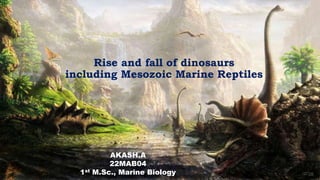The document summarizes the Mesozoic Era from 251 to 65 million years ago, known as the Age of Reptiles. It describes the rise and fall of dinosaurs and other marine reptiles that dominated during this time period. Key events included the breakup of Pangaea, the emergence of dinosaurs and flying reptiles, and the dominance of various marine reptiles like ichthyosaurs, mosasaurs, and plesiosaurs. The document also discusses prominent dinosaur genera that lived during the Triassic, Jurassic, and Cretaceous periods, such as Plateosaurus, Allosaurus, Tyrannosaurus Rex, and Velociraptor. It concludes by outlining the asteroid

































